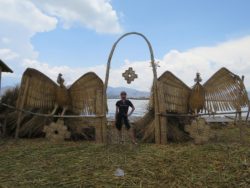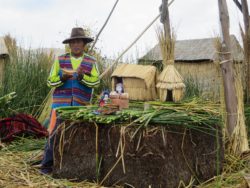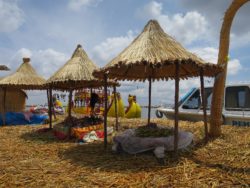Floating Islands of Lake Titicaca
Titicaca. Get your giggles out now. Nestled in the mountains between Peru and Bolivia, Lake Titicaca is the highest navigable lake in the world, sitting at just over 12,000 feet above sea level. For hundreds of years before the Incas took over, and continuing on to this day, the Uru people have lived in self-constructed floating islands on the lake, and we had a chance to go check out this unique civilization for ourselves.
The islands, as well as the majority of structures on them, are constructed almost exclusively from totora, a papyrus-like reed that grows in abundance in the lake. The reeds and their roots are both extremely buoyant, and the Uros are masters of packing and binding the reeds to form homes, boats, and even decorations. The self-proclaimed “president” of the island we visited gave us a demonstration of the construction of a new island, which usually takes between one and two years to complete. The roots are bound together and form the base of the island, and the reeds are layered on top to form the soft straw surface. Every two or three months, a new layer of reeds is required on the surface, and the island itself will last between 25 and 30 years, at which point the families will have to construct and relocate to a new one.
Historically the Uros were fishermen that would trade with other tribes for more varied goods, but due to overfishing, there are now regulations in place that restrict them from fishing above a sustenance level. Their culture now relies on tourism as a result, and there were numerous stalls set up with kitschy “handmade” souvenirs of varying quality and authenticity.
It did feel a bit contrived at times, like when they sang us a “welcome song” as we were getting off the boat, but when your whole economy relies on tourism, I suppose you do everything you can to play it up. The people aren’t entirely cut off from civilization; they go shopping on dry land and some families even send their kids to school there. Their way of life is certainly different from the mainlanders just a few kilometers away, however. Most families share a one-room hut made from reeds, all sleeping in the same bed for warmth. Privacy is a bit hard to find on an island of just a few hundred square meters; at one point the “president” pointed out a boat that he called a taxi romantico. According to him, “two people leave on the romantic taxi, and three come back”.
Puno and Titicaca are our last stops in Peru; from here we’re heading south to our fourth country, Chile!













Ever since I learned of Lake Titicaca in grade school I’ve dreamed of visiting one day. The main reason: to say I’m going to Titicaca (your dad will vouch for my sophomoric humor.) Thanks for yet another quick trip from my desk chair. Safe travels.
we’re really enjoying your travels on your blog. Thanks for sharing. Stay safe, both of you. xo